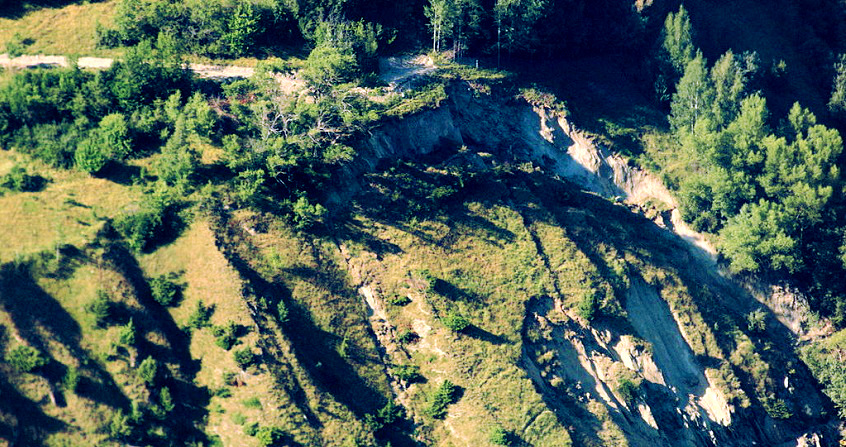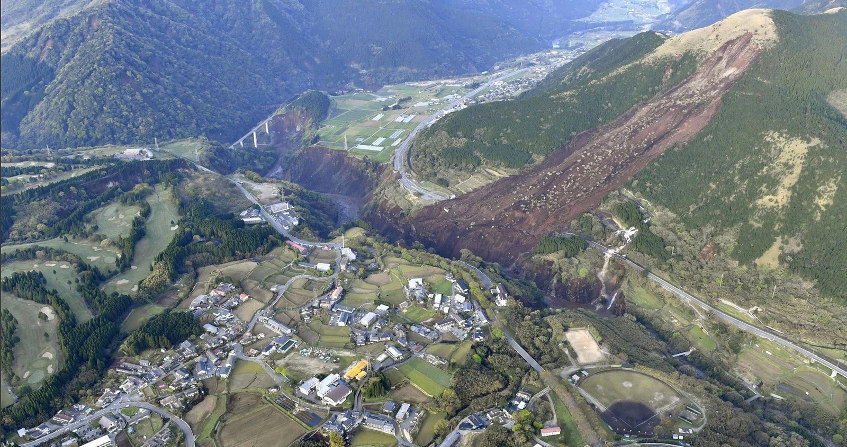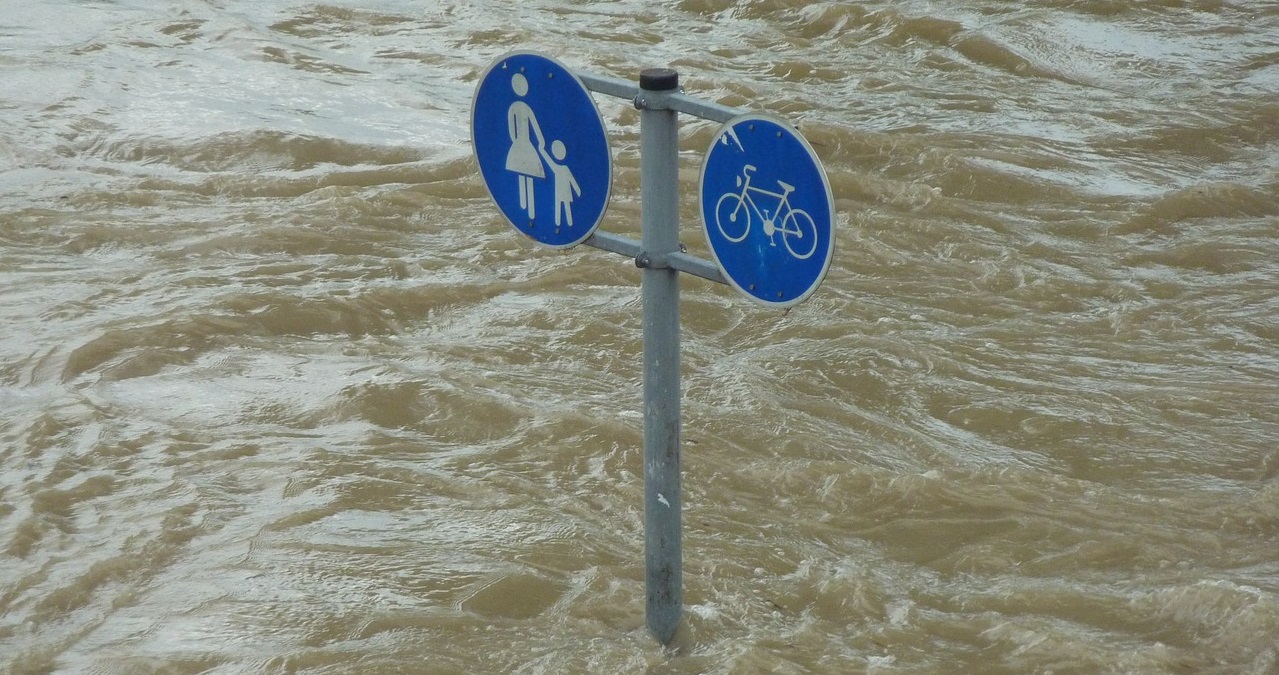岩体滑坡和崩塌,死路一条?
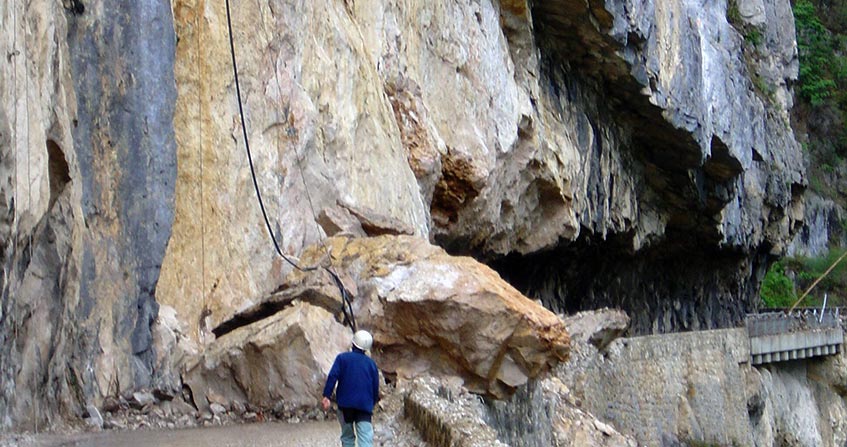
在年轻的山脉(喜马拉雅山脉、安第斯山脉、阿尔卑斯山脉等)区,滑坡等岩石崩塌现象十分频繁,有时石块体积巨大,因此是主要自然灾害。其造成的地面破裂几乎遍布所有岩体中的结构软弱面。这些结构面源于成岩过程(沉积岩的层理面、岩浆岩的冷缩裂隙等),或构造运动(构造过程中因板块运动形成大小不一的裂缝和断层)。岩体失稳可能局限于表层,波及范围有限,如所有泄洪区都经常出现石块和碎屑崩落。然而,特定岩体的非连续面与边坡走向上,岩层滑动或翻转程度也相对较大,最终形成的大型滑坡体可达数千万立方米。不幸的是,地震后时常发生大型岩体断裂(如1970年的瓦斯卡兰山(Huascaran), 和2014年的尼泊尔(Nepal)。尽管可以采取支挡、锚固、防护网等岩体防护措施,但要将其应用于所有已确定风险的地点,如城市、村庄、山路或岩石海岸附近的悬崖,所需成本巨大、难以承受。
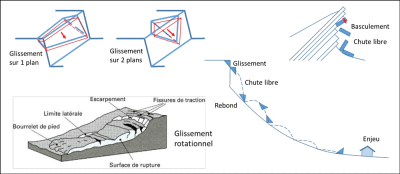
(glissement sur 1 plan 在一个平面上滑移,glissement sur 2 plan 在两个平面上滑移, glissement 滑移, chute libre 自由落体, rebond 回弹, Enjeu 利害关系者, Basculement 倾斜,glissement rotationnel 旋转滑移, Escarpement 滑坡壁, Fissures de traction 拉伸裂纹, Limite latérale 滑坡周界, Bourrelet de pied 滑坡舌, Surface de rupture 破裂面)
通常根据发生机制对边坡移动进行分类,如滑动、倾倒、坠落、流动(图1),移动体的体积从立方分米到几百立方百米(一立方百米相当于一个100米的山脊立方体,或一百万立方米)。
其移动速度相差巨大,从每年几毫米到超过100公里/小时(接近在空气中自由落体的速度)。本文简述了岩质滑坡这一类别(请参阅《滑坡》)。
1. 岩质滑坡
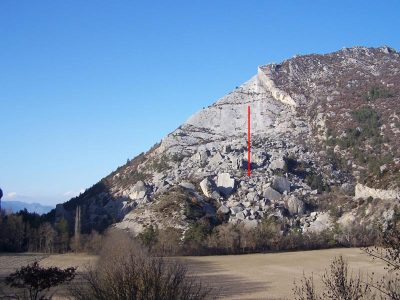
滑坡是指大块土壤或岩石在特定断裂面上移动。根据断裂面形状分为不同类型的滑移。
平推式滑坡通常发生于岩体中已存在的一个或两个非连续面(称为楔形面)。法国迪瓦地区吕克市镇的滑坡事件(Claps de luco-en-diois)就是典型例子:1442年,由于德龙(Drôme)河侵蚀了边坡底部,厚厚的石灰岩层在层理面上发生滑动(图2)。滑坡体积超过1 hm3。但过去两千年里,阿尔卑斯山地区最大的滑坡是1248年11月影响格拉尼尔山(Mont Granier)北部泥灰岩边坡的滑坡事件。近500 hm3的泥灰岩在层状节理上向东滑动,摧毁了好几个村庄,造成1000多人死亡(图3)。
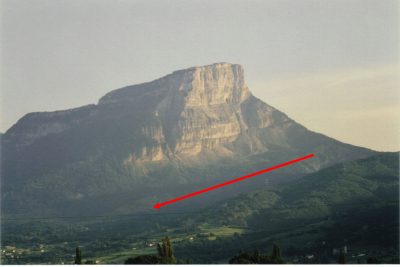
旋转型滑坡发生于轴对称表面;有时被称为圆弧型滑坡,因为在垂直截面上,滑动面呈圆弧状。这类滑坡可能发生在连续性地块 (如土壤) 中,也可能在没有非连续面的情况下发生平推式滑坡。从法国昆布兰市镇的滑坡(La Clapière)到圣艾蒂安德锡涅村的滑坡(Saint-Etienne-de-Tinée)就属于旋转型滑坡,滑坡体约为50 hm3(图4)。
其他类型的滑坡称为复合(或分裂)型滑坡,因为涉及岩体内部形变或滑动体分裂。
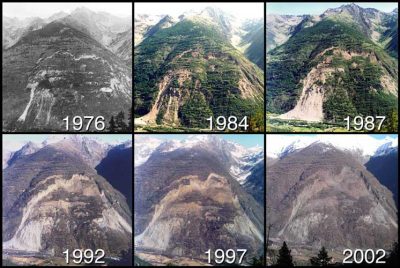
人类也能引发山体滑坡。最著名的例子是意大利托克山(Mont Toc)滑坡。瓦依昂(Vajont)水库大坝落成并蓄水后,270 hm3的岩石滑进水库,导致水大量溢出大坝,50 m高的水墙摧毁了隆加罗市(Longarone)(导致2000人遇难)。2001年上映的电影《人类的疯狂》(La folie des hommes)讲述了这场灾难。这次滑坡是20世纪阿尔卑斯山规模最大的高速滑坡。
2. 倾倒
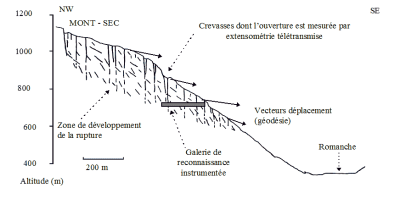
(Altitude 海拔,MONT-SEC SEC山, NW 西北方向,SE 东南方向,Crevasses dont l’ouverture est mesurée parextensométrie télétransmnise 用远程应变计测量裂缝宽度,Vecteurs déplacement (géodésie) 位移矢量(大地测量学),Zone de développement de la rupture 断裂发展区,Galerie de reconnaissance instrumentée 仪器监测廊道,Romanche 罗曼什河)
倾倒是滑坡体围绕其重心下方旋转轴翻转的过程。已有裂隙的岩块发生翻倒与岩层或岩壁发生弯曲不同。法国塞希利耶讷市镇(Séchilienne)塞克山(Mont Sec)的滑坡(图5)是近乎垂直的河岸发生了翻倒,形变层厚度超100 m,导致形成新裂缝,这些裂缝的状态仍在监测中。
3. 岩崩
岩崩是指岩石在边坡上发生飞溅、弹跳或滚动等快速运动。这在山区非常常见,也见于有悬崖和岩石峭壁的沿海地区。岩崩发生前,相关岩体通常会发生滑坡或倾倒。如果仅有碎石崩落,那落石间几乎没有相互作用。而在大规模岩质滑坡和岩崩中,石块如同颗粒一样流动,块体间的相互作用至关重要,这些块体从几dm3到几百m3不等,滑坡体总体积可达数十hm3。阿尔卑斯山区在20世纪发生了两次大规模山体滑坡,一次是意大利伦巴第的瓦尔波拉(Val Pola)山体滑坡,另一次是瑞士瓦莱州的兰达(Randa)山体滑坡。
4. 如何预测边坡行为?
需要专业工程师来研究不同情况下的边坡运动:(a)诊断当前稳定的边坡(其稳定性能维持多久?);(b)设计现有边坡的清除(或切割)或加固工程(采用多大坡角,须安置多少锚杆?);(c)监测缓慢移动的不稳定边坡(是否有快速移动的风险?如有,何时发生?)。上述活动采用的研究方法因背景条件和目的而异。
4.1. 诊断稳定边坡
利用和规划土地时,必须考虑边坡在百年人类活动时间尺度(human time scale)上的稳定性。为确定给定时间内是否有发生危害的可能,必须明确当前稳定状态(“过”稳定)和可能导致失稳的过程。岩质边坡的稳定性主要取决于鲜为人知的内部结构(岩石不连续面的分布),岩石强度及其不连续性。可能降低岩体稳定性并导致其破裂的主要因素包括:水的存在、冰的作用、地震和其他振动、坡脚受侵蚀或挖掘、过载。如果这些因素是自然产生的,则无法断定其演变进程。此外,我们往往并不了解这些因素的确切作用过程,因而很难模拟。基于此,只能用发生概率来预测和表述稳定边坡的未来行为,专家采用“危险度”一词描述岩体的潜在不稳定性。
我们无法定量特定岩体破裂的概率(局地性风险),但可以根据历史数据库或地貌测量(如使用激光扫描仪)边坡或匀质地区的边坡位移(弥散性风险),估算单位面积的断裂数量及断裂发生时间(频率)。例如,格勒诺布尔(Grenoble)附近圣埃纳尔山(Mont Saint-Eynard)悬崖的激光扫描仪连续测量结果表明,每年每公顷(hm2:边长为100米的正方形)面积上坠落的岩石体积超过1 m3。
4.2. 边坡清理或加固设计
这方面不再考虑失稳发生的时间,而是确保不发生失稳。因此,通常采用悲观模型(换言之,预防性原则)分析所关注边坡的稳定性:最常见的情况是,由于缺乏信息,我们假设断裂面无限延伸;模型参数不取最可能的值,而是发生可能性更低的值。另外,目标通常是达到过稳定状态。如果达不到,则需要修改相应工程,例如减小坡角等。
评估岩体稳定程度最快捷方法是将位移描述为岩体在单个平面上的滑动:比较引起滑动的力(滑动力)和对抗滑动的最大力(抗滑力),抗滑力与滑动力的比值即为边坡稳定性安全系数(safety factor)。只有安全系数大于1才能认定边坡稳定。滑动力的计算不仅要考虑岩体的质量,还要考虑地震或者水渗入边坡等潜在临时事件产生的应力。
更复杂的数值方法还有离散元法,也可用于计算开挖引起的岩体位移,进而分析滑坡的复杂机理,确定位移量是否在接受范围内。与上述基于静态分析的方法不同,离散元法基于动力学原理或牛顿第二定律。
4.3. 慢速位移的不稳定边坡监测
一旦发现边坡位移并形成风险,必须对其进行监测,通常包括测量边坡或岩体中标志物(如钻孔或坑道)的位移。受雨水或融雪后渗入边坡的水和地震等的影响,位移速度很少恒定。经验表明,没有外部因素的情况下,如果位移速度增加,那这种加速趋势可能一直持续,直至边坡坍塌,滑坡体完全脱离起始区域,高速冲向下方。图4为监测边坡的实际例子(见上文)。
5. 岩石的运移距离能有多远?
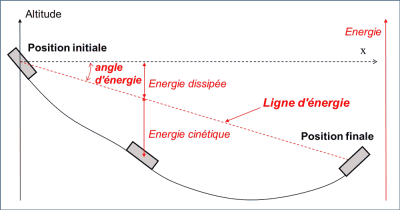
(Altitude 海拔,Energie 能量,Position initiale 初始位置, Position finale 最终位置,angle d’énergie 能量角,Energie dissipée 能量耗散,Ligne d’énergie 能量线,Energie cinétique 动力学能量)
多种力学方法都可用于计算滑坡造成的岩石运动距离。第一个方法基于能量角,可以量化滑坡体位移过程中的能量损失(图6)。滑坡体位移停止时,其势能较位移前更低;在一个边坡剖面中,从位移起始区域画一条线(能量线) ,且其倾角等于能量角,即可判定滑坡体的停止点。三维空间中,停止点位于地形曲面与锥体的交点,锥体顶点为起始区域。对于几百hm3的滑坡体,能量角可以小于10°。格兰尼尔(Granier)滑坡便是典型的例子,滑坡体移动距离超过8公里。岩体崩塌的能量角一般约40°,但位移量最大的岩崩能量角低于30°。
能量的耗散方式:发生不完全弹性形变岩石的回弹、岩体碎裂、发出震动波、损毁树木等。
对于落石,可采用合适的软件计算其在边坡上坠落、弹跳或滚动的轨迹。虽然坠落轨迹的计算较为容易,但难以建立弹跳模型,可以借助能量恢复系数(energy restitution coefficients),该系数表示岩块在边坡弹跳或与另一块体碰撞后初始能量的留存比例。此外,对停留在边坡上落石的观察可为预测落石发生范围和频率提供有效信息。当然,观察结果可能存在偏差,因为近几个世纪,这些落石可能因自然因素或人类使用发生过移动。
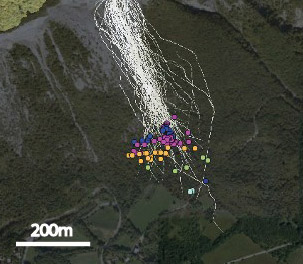
图7展示了使用Rockyfor3D软件模拟格勒诺布尔(Grenoble)附近的圣埃纳德堡(Saint-Eynard)山体滑坡。
若块体数量多,块体间相互作用强(岩崩与碎屑流),可以将其视为流体,使用散体力学定律建模。该方法也可模拟长距离、流体形式移动的滑坡(滑坡导致的泥石流)。
6. 自我防护/如何免受岩体失稳伤害
有两类自然灾害防护措施。主动防护旨在消除危害本身,被动防护的目的不在于消除自然现象,而是降低其对建筑物、通讯等的不利影响。
主动防护方法颇多,包括:
- 通用方法,如地表或地下排水,以及利用护坡植被限制径流导致的侵蚀(沟蚀)和机械性能(摩擦力,岩石节理的黏聚力)改变后的渗透;
- 支护,如挡土墙、锚杆或用喷射混凝土覆盖的锚网;
- 防护网(悬挂或沿壁锚定),即金属网结构,用以滞留块体和防止坠落石块飞溅;
- 清理与挖除:这些解决方法也可消除不稳定因素,但较为激进,且并非总能达到预期,例如持续形变以及爆破导致的振动往往会损害被清除部分周围地块的稳定性。
被动防护方法也有很多:
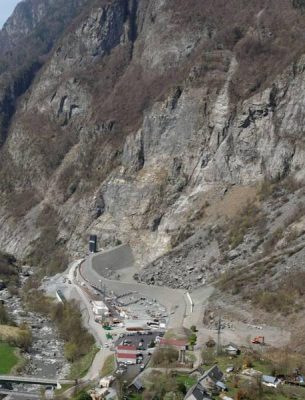
图8. 防护障。[图片来源:加维特(Gavet),世哲出版(Sage)] - 导流堤是修筑在边坡上的堤坝,旨在将落石引导至没有风险的地方;
- 棚硐,类似于应对雪崩的隧道,可以保护落石区的交通路线;
- 在陡峭的边坡上设置刚性防护装置,尽量靠近岩石松动区域,但这类设施安装难度很大。
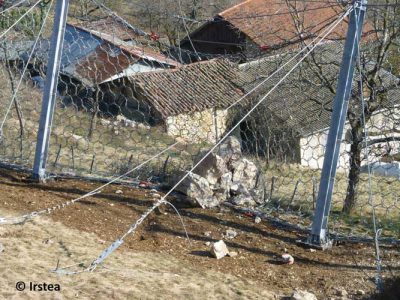
图9. 里帕伊勒(Ripailler)地区的柔性防护网。[图片来源:国家环境与农业科技研究院(IRSTEA)]
积极采取措施可有效降低岩石失稳风险,但往往需要大量资金,因此,不可能完全清除所有风险点。最好的防护措施是先进行地质勘察评估风险,采取有效预防措施(如排水和定期清除不稳定岩石),并在发现岩石位移后持续监测,为必要时封闭道路或疏散居民提供预警。
环境百科全书由环境和能源百科全书协会出版 (www.a3e.fr),该协会与格勒诺布尔阿尔卑斯大学和格勒诺布尔INP有合同关系,并由法国科学院赞助。
引用这篇文章: FABRE Denis, HANTZ Didier (2024年3月12日), 岩体滑坡和崩塌,死路一条?, 环境百科全书,咨询于 2024年4月26日 [在线ISSN 2555-0950]网址: https://www.encyclopedie-environnement.org/zh/sol-zh/rocky-landslides-and-landslides-a-fatality/.
环境百科全书中的文章是根据知识共享BY-NC-SA许可条款提供的,该许可授权复制的条件是:引用来源,不作商业使用,共享相同的初始条件,并且在每次重复使用或分发时复制知识共享BY-NC-SA许可声明。







